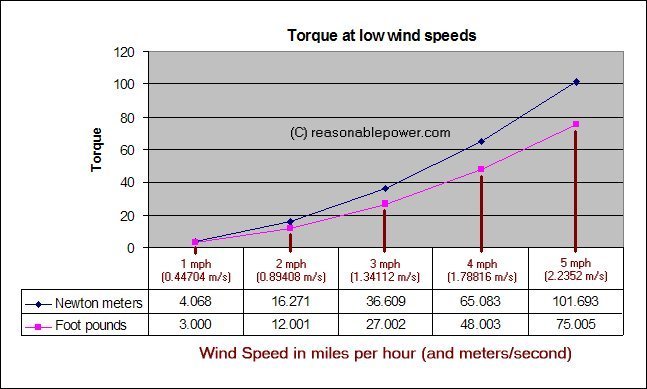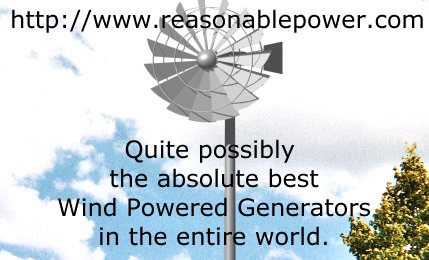|
Our page with email address is liked from our "Wind Powered Generator Prices" page.
|
INDEX
|
-
Wind Powered Generator Prices
Wind Powered Generator Prices
With discussions of:
-
- Grid Tying,
- Tower Foundations,
- Production Charts,
- Home Improvement Contractors,
- Determining Your Wind Velocity Rating,
- Optional Computer Data Interface,
- Volume Purchasing Discounts,
- Shipping.
|
-
Wind Energy Facts
Wind Energy Facts.
Reasonably Designed and
Logically Considered.
Reference:
-
- Archimedes,
- Wilber and Orville Wright,
- Physics,
- NASA.
|
-
Reasonable Power Home Page
|
|
|
|
-
An Introduction to Wind Loads
A Worked Through Example of Wind Loading explained in detail.
Example Formulas,
Example Calculations,
Example Definitions.
|
-
Aerodynamic Characteristics
Aerodynamic Characteristics
with references to Sandia National Laboratories research.
YES !
More Direct DATA and Physics FACTS for you to understand why we do not build silly illogical waste-of-space three-bladed "aerofoil lift" wind turbines.
Oh. Yes.
Read and Know.
|
-
Another look at those Graphs
Go look again.
Sandia National Laboratories
Research.
Get the impact of these graphs in you head.
The results of this research might SERIOUSLY impact your financial future!
Now, go look at those graphs again.
|
-
Battery Bank Comparison
Battery Banks.
Battery Bank Design,
Comparing Battery Banks,
Discussions, Definitons, Examples,
Tables of Volts, Amps, Watts, etc.
|
-
Supplier Guidelines
Purchasing Internationally
If you want to supply to us,
Please consider:
Attitude,
Product Availability,
Price Availability,
and
Product Quality.
|
-
Vertical Axis Wind Turbines, VAWT
Vertical Axis Wind Turbines
VAWT
Similar to those three bladed "aerofoil lift" horizontal wind turbines
Silly.
Illogical.
Waste-of-space.
They are silly, illogical, and a waste-of-space.
Go back to graphs on our Aerodynamics Characteristics page again.
You should know this already.
|
-
Wind Turbine Pictures
A page of Wind Turbine Pictures.
A page of:
Silly,
illogical,
waste of space,
3 bladed, "aerofoil lift",
Wind Turbines.
|
|
-
Wind Speed Sensors
Wind Speed Sensors.
Wind Sensor Manufacturers.
Wind Sensor Suppliers.
Companies that were nice enough to ask us to list them.
Give them a chance.
Check out their products.
|
|
-
Registered Reference Agreement
Registered Reference Agreement.
How to get $500 as a REGISTERED Reference to a completed sale.
It is OUR POLICY to pay someone for the reference, even if we have to guess at who referenced the customer to us.
|
-
Non-Registered Reference Agreement
(On the same page but further down. Read the entire page.)
Non-Registered Reference Agreement.
How to get $500 as a NON-Registered Reference to a completed sale.
It is OUR POLICY to pay someone for the reference, even if we have to guess at who referenced the customer to us.
|
|
|
|
|
|
Torque on the transfer shaft.

The graph shows the torque on the transfer shaft at the initial impact of the wind load on our 14 foot model of our Wind Powered Generators. This is before the blades start turning. It is the initial torque due to the wind. The initial torque is the proper reference to compare between various types of wind energy devices. After the initial torque, when the blades turn, or in any processes later, a comparison between wind energy systems becomes speculative.
When you are comparing products, look at the initial startup torque. ASK what the startup torque is. If our competitors try to confuse you with rotation speeds compared to gear ratios, or anything else besides the actual torque force created by the initial impact of the wind on the blades then DEMAND to know the initial torque on the transfer shaft created by the blades. If our competitors pretend to not understand what you are demanding, send them to our web page, and DEMAND that they give comparitive data. THINK! ASK! DEMAND TO KNOW!
|



